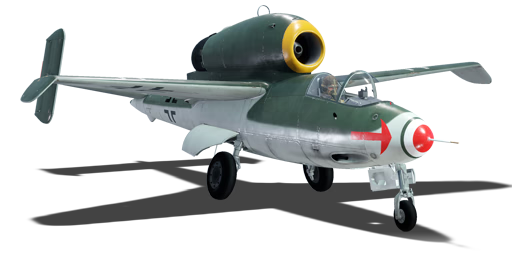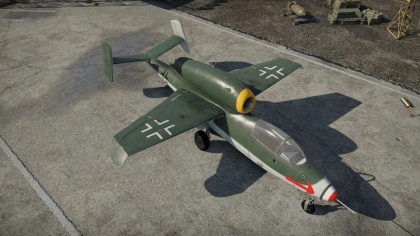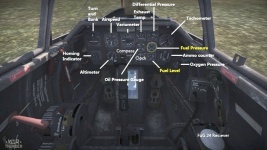He 162 A-2
Contents
| This page is about the German jet fighter He 162 A-2. For other version, see He 162 A-1. |
Description
The He 162 A-2 is a rank German jet fighter
with a battle rating of (AB), (RB), and (SB). This jet fighter has been in the game since the start of the Open Beta Test prior to Update 1.29.
General info
Flight Performance
Describe how the aircraft behaves in the air. Maximum speed, manoeuvrability, speed and allowable loads - these are the most important characteristics of the vehicle.
| Characteristics | |||||||
|---|---|---|---|---|---|---|---|
| Stock | |||||||
| Max Speed (km/h at 6,000 m) |
Max altitude (meters) |
Turn time (seconds) |
Rate of climb (meters/second) |
Take-off run (meters) | |||
| AB | RB | AB | RB | AB | RB | ||
| 800 | 774 | 31.5 | 32.7 | 19.1 | 18.0 | 750 | |
| Upgraded | |||||||
| Max Speed (km/h at 6,000 m) |
Max altitude (meters) | Turn time (seconds) | Rate of climb (meters/second) |
Take-off run (meters) | |||
| AB | RB | AB | RB | AB | RB | ||
| ? | ? | ??.? | ??.? | ??.? | ??.? | 750 | |
Details
| Features | ||||
|---|---|---|---|---|
| Combat flap | Take-off flap | Landing flap | Air brakes | Arrestor gear |
| ✓ | ✓ | ✓ | X | X |
| Limits | ||||
|---|---|---|---|---|
| Wing-break speed (km/h) |
Gear limit (km/h) |
Combat flap (km/h) |
Max Static G | |
| + | - | |||
| 700 | ~31 | ~18 | ||
| Optimal velocities | |||
|---|---|---|---|
| Ailerons (km/h) |
Rudder (km/h) |
Elevators (km/h) |
Radiator (km/h) |
| < 500 | < 500 | < 580 | > 250 |
Survivability and armour
- 15 mm steel - bulkhead behind cockpit
- Engine exposed on top of the fuselage
- Fuel tanks in fuselage and wings below the engine
Armaments
Offensive armament
The He 162 A-2 is armed with:
- 2 x 20 mm MG 151 cannon, chin-mounted (120 rpg = 240 total)
The twin MG 151s have the least stopping power out of all the early Tier 5 jets. However, when compared to the 30 mm Mk. 108's found on other German jets, its cannons have acceptable muzzle velocity, though this will remain a problem. The ammo count is less than enough considering the speeds at which jet combat takes place.
Usage in battles
Describe the tactics of playing in an aircraft, the features of using vehicles in a team and advice on tactics. Refrain from creating a "guide" - do not impose a single point of view, but give the reader food for thought. Examine the most dangerous enemies and give recommendations on fighting them. If necessary, note the specifics of the game in different modes (AB, RB, SB).
Manual Engine Control
| MEC elements | ||||||
|---|---|---|---|---|---|---|
| Mixer | Pitch | Radiator | Supercharger | Turbocharger | ||
| Oil | Water | Type | ||||
| Not controllable | Not controllable | Not controllable Automatic |
Not controllable | Separate | Not ontrollable | Not controllable |
Modules
"Offensive 20mm", "Compressor", "Wings repair" then "Engine" in that and no other order! Why? The stock Mg151 belts are bad as they lack the very powerful HE Minengeschosse. Compressor and Engine are no brainers. Everything that improves acceleration is a must for early jets. Wings repair is superior to new cannons, the stock Mg151 does not overheat and accuracy is acceptable in short bursts.
| Tier | Flight performance | Survivability | Weaponry | ||
|---|---|---|---|---|---|
| I | Fuselage Repair | Radiator | |||
| II | Compressor | Airframe | |||
| III | Wings Repair | Engine | |||
| IV | Engine Injection | Cover | |||
Pros and cons
Pros:
- Top speed in comparison to propeller planes
- Relatively quick jet with OK acceleration at its rank
- Good climb rate for an early jet, climbs better than American jets of the same rank
- Excellent dive rate, can catch up even the MiG-9s in shallow dive
- Hard-hitting armament of two MG 150/20s
- Does not have WEP, however throttle can push past 100% (up to 108% throttle)
- Very good visibility
- Good Energy Retention
- Little wing surface area means small target when turning
- Can use WEP almost indefinitely above 6,000 m
- Great roll rate
- Affordable repair cost
- Loses little energy in rudder turns
Cons:
- Outgunned and out-turned by later jets when up-tiered
- Lackluster top speed in comparison to other comparable jets
- Acceleration is much weaker than in any later propeller planes or later jets
- Turn radius isn't any advantage for this plane towards other jets
- Bleeds whole energy during elevator turns
- Extended usage of the throttle over 100% burns up the jet engine (deteriorates quality of use until its own destruction)
- Difficult take off, struggles on some airfields
- Good energy retention + high speed + absence of airbrakes = hard landing
- Low roll stability
- Engine mounted on top, vertical manoeuvre techniques need to account for the pitching-down moment of the engine thrust
- Engine easily overheats below 2,000 m
History
Initially, this Heinkel fighter was designated He 500, but by October, in order to fool enemy intelligence services, the RLM redesignated the plane He 162; the number being previously assigned to a Messerschmitt fast bomber prototype that competed with the Ju 88. At the same time, the fighter was named the Salamander, which initially was the codename for the very same fast bomber design. The official name at the start of introduction was Volksjäger to emphasize the usage as every man's fighter similar to Volkswagen aka VW.
Overall 170 to 320 aircraft were produced, most of them A-2 variants. The previous A-1 were first fitted with Mk108, but these shocked the airframe too hard and were changed into the less recoil-heavy Mg151/20. An interesting feature is the dorsal mounted engine. It serves two purposes; first: Easier maintenance like with Me 262s underwing gondolas and second - and most importantly: The high installation greatly reduced foreign object damage - or FOD. Unpaved runways were common on all sides in WW2 and rocks and other debris were often sucked into the intake -- the main cause of engine failures in early jets.
Albeit named the Volksjäger, the jet was a dangerous vehicle for beginners. Short flight time and a high stall speed compared to the gliders most recruits trained on caused a high after-combat crash rate, especially on landing approaches. Pilots often failed to attain the recommended landing speed of 250 kph (100 more than the Bf109) due either inexperience or lack of fuel. The high landing speed was the cause of even more deadly problems.
In the air, however, the aircraft was praised even by its foes. Allied pilots loved to take the captured He 162s into the air, praising its smooth flight and good controllability. The only downside was the weak rudder and weak in the literal meaning. RAF pilot, Flt Lt. R. A. Marks, despite being instructed not to use heavy rudder on high speed, performed a low-altitude, high-speed barrel roll during a demonstration. A fin and rudder assembly ripped out of its socket, the sudden loss of control and insufficient height resulted in a fatal crash.
Like the Me 262 Schwalbe, the Volksjäger proved to be too little too late.
In-game description
Initially, this Heinkel fighter was designated He 500, but by October, in order to fool enemy intelligence services, the RLM redesignated the plane He 162; the number being previously assigned to a Messerschmitt fast bomber prototype that competed with the Ju 88. At the same time, the fighter was named the Salamander, which initially was the codename for the entire program.
Media
An excellent addition to the article will be video guides, as well as screenshots from the game and photos.
See also
Links to the articles on the War Thunder Wiki that you think will be useful for the reader, for example:
- reference to the series of the aircraft;
- links to approximate analogues of other nations and research trees.
External links
Paste links to sources and external resources, such as:
- topic on the official game forum;
- encyclopedia page on aircraft;
- other literature.
| Germany jet aircraft | |
|---|---|
| |
Luftwaffe |
| He 162 | He 162 A-1 · He 162 A-2 |
| Me 163 | Me 163 B · Me 163 B-0 |
| Ho 229 | Ho 229 V3 |
| Ar 234 | Ar 234 B-2 · Ar 234 C-3 |
| Me 262 | Me 262 A-1a · Me 262 A-1a/Jabo · Me 262 A-1a/U1 · Me 262 A-1/U4 · Me 262 A-2a |
| Me 262 C-1a · Me 262 C-2b | |
| |
LSK |
| Fighters | ◊MiG-15bis · ◊Lim-5P · ◊MiG-19S |
| ◊MiG-21MF · ◊MiG-21bis-SAU · ◊MiG-21 "Lazur-M" | |
| ◊MiG-29 | |
| Attackers | ◊MiG-23BN · ◊MiG-23MF · ◊MiG-23MLA |
| ◊Su-22UM3K · ◊Su-22M4 | |
| ◊IL-28 | |
| |
Luftwaffe |
| F-84 | ◄F-84F |
| F-86 | ◄CL-13A Mk 5 · ◄CL-13B Mk.6 · ◄F-86K |
| F-104 | ◄F-104G |
| F-4 | ◄F-4F Early · ◄F-4F · ◄F-4F KWS LV |
| G.91 | ◄G.91 R/3 · ◄G.91 R/4 |
| Tornado | ◄Tornado IDS WTD61 · ◄Tornado IDS MFG · ◄Tornado IDS ASSTA1 |
| Other | Alpha Jet A · ◄Sea Hawk Mk.100 |
| Ex-LSK | ◄MiG-21 SPS-K · ◄MiG-29G · ◄Su-22M4 WTD61 |
| |
Swiss Air Force |
| ◌Hunter F.58 · FFA P-16 | |






